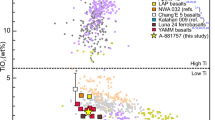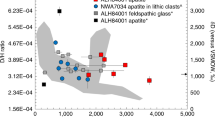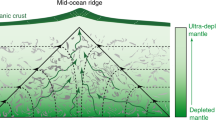Abstract
The early stages of planetary differentiation are characterized by the formation of magma oceans, which crystallize from the base up1,2. The final, iron-rich residues of crystallization are dense and therefore tend to sink into the mantle, whereas the deeper, magnesium-rich material tends to rise up3,4. The resultant mantle overturn would have had a profound influence on the evolution of the planets3,4,5,6. Such an event probably occurred on Mars, but its initiation, timing and geochemical consequences are poorly constrained. Here we use isotopic data for nakhlite meteorites—chunks of martian crust transported to the Earth—and numerical simulations to constrain the evolution of the early martian mantle. We interpret the isotopic composition of the meteorites as evidence for an episode that occurred relatively early in Mar’s history, about 100 million years after the planet’s formation, during which garnet was removed from material that rose up from the deep mantle. This episode implies large-scale reorganization in the martian mantle and thereby provides compelling support for overturn. We suggest that this event probably led to substantial re-melting in the deepest mantle, which may have influenced early martian processes such as the development of crustal dichotomy.
This is a preview of subscription content, access via your institution
Access options
Subscribe to this journal
Receive 12 print issues and online access
$259.00 per year
only $21.58 per issue
Buy this article
- Purchase on Springer Link
- Instant access to full article PDF
Prices may be subject to local taxes which are calculated during checkout



Similar content being viewed by others
References
Solomatov, V. S. & Stevenson, D. J. Non-fractional crystallization of a terrestrial magma ocean. J. Geophys. Res. 98, 5391–5406 (1993).
Abe, Y. Thermal and chemical evolution of the terrestrial magma ocean. Phys. Earth Planet. Inter. 100, 27–39 (1997).
Elkins-Tanton, L. T., Parmentier, E. M. & Hess, P. C. Magma ocean fractional crystallization and cumulate overturn in terrestrial planets: Implications for Mars. Meteorit. Planet. Sci. 38, 1753–1771 (2003).
Elkins-Tanton, L. T., Hess, P. C. & Parmentier, E. M. Possible formation of ancient crust on Mars through magma ocean processes. J. Geophys. Res. 110, E12S01 (2005).
Hess, P. C. & Parmentier, E. M. A model for the thermal and chemical evolution of the Moon’s interior: Implications for the onset of mare volcanism. Earth Planet. Sci. Lett. 134, 501–514 (1995).
Elkins-Tanton, L. T., Zaranek, S. E., Parmentier, E. M. & Hess, P. C. Early magnetic field and magmatic activity on Mars from magma ocean cumulate overturn. Earth Planet. Sci. Lett. 236, 1–12 (2005).
Harper, C. L. et al. Rapid accretion and early differentiation of Mars indicated by 142Nd/144Nd in SNC meteorites. Science 267, 213–217 (1995).
Treiman, A. H. The nakhlite meteorites: Augite-rich igneous rocks from Mars. Chem. Erde-Geochem. 65, 203–296 (2005).
Caro, G., Bourdon, B., Halliday, A. N. & Quitté, G. Super-chondritic Sm/Nd ratios in Mars, the Earth and the Moon. Nature 452, 336–339 (2008).
Boyet, M. & Carlson, R. W. 142Nd evidence for early (>4.53 Gyr) global differentiation of the silicate Earth. Science 309, 576–581 (2005).
Debaille, V., Brandon, A. D., Yin, Q.-Z. & Jacobsen, B. Coupled 142Nd–143Nd evidence for a protracted magma ocean in Mars. Nature 450, 525–528 (2007).
Misawa, K., Shih, C.-Y., Wiesmann, H. & Nyquist, L. E. Crystallization and alteration ages of the Antarctic nakhlite Yamato 000593. Lunar Planet. Sci. Conf. XXXIV abstr. 1556 (2003).
Shih, C.-Y., Nyquist, L. E. & Reese, Y. Rb–Sr and Sm–Nd isotopic studies of Antarctic nakhlite MIL 03346. Lunar Planet. Sci. Conf. XXXVII abstr. 1701 (2006).
Lee, D.-C. & Halliday, A. N. Core formation on Mars and differentiated asteroids. Nature 388, 854–857 (1997).
Foley, N. C. et al. The early differentiation history of Mars from 182W–142Nd isotope systematics in the SNC meteorites. Geochim. Cosmochim. Acta 69, 4557–4571 (2005).
Kleine, T. et al. 182Hf–182W isotope systematics of chondrites, eucrites, and Martian meteorites: Chronology of core formation and early mantle differentiation in Vesta and Mars. Geochim. Cosmochim. Acta 68, 2935–2946 (2004).
Blichert-Toft, J., Gleason, J. D., Telouk, P. & Albarède, F. The Lu–Hf isotope geochemistry of shergottites and the evolution of the Martian mantle–crust system. Earth Planet. Sci. Lett. 173, 25–39 (1999).
Wadhwa, M. & Crozaz, G. Trace and minor elements in minerals of nakhlites and Chassigny: Clues to their petrogenesis. Geochim. Cosmochim. Acta 59, 3629–3645 (1995).
Borg, L. E. et al. The age of Dar al Gani 476 and the differentiation history of the Martian meteorites inferred from their radiogenic isotopic systematics. Geochim. Cosmochim. Acta 67, 3519–3536 (2003).
Bouvier, A., Blichert-Toft, J. & Albarède, F. Martian meteorite chronology and the evolution of the interior of Mars. Earth Planet. Sci. Lett. 280, 285–295 (2009).
Draper, D. S., Xirouchakis, D. & Agee, C. B. Trace element partitioning between garnet and chondritic melt from 5 to 9 GPa: Implications for the onset of majorite transition in the Martian mantle. Phys. Earth Planet. Inter. 139, 149–169 (2003).
Bouvier, A., Vervoort, J. D. & Patchett, J. The Lu–Hf and Sm–Nd isotopic composition of CHUR: Constraints from unequilibrated chondrites and implications for the bulk composition of terrestrial planets. Earth Planet. Sci. Lett. 273, 48–57 (2008).
Righter, K. & Shearer, C. K. Magmatic fractionation of Hf and W: Constraints on the timing of core formation and differentiation in the Moon and Mars. Geochim. Cosmochim. Acta 67, 2497–2507 (2003).
Halliday, A. N., Wänke, H., Birck, J. L. & Clayton, R. N. The accretion, composition and early differentiation of Mars. Space Sci. Rev. 96, 197–230 (2001).
Bouvier, A. et al. Pb–Pb dating constraints on the accretion and cooling history of chondrites. Geochim. Cosmochim. Acta 71, 1583–1604 (2007).
Bertka, C. & Fei, Y. Mineralogy of the Martian interior up to core–mantle boundary pressures. J. Geophys. Res. 102, 5251–5264 (1997).
Debaille, V., Yin, Q.-Z., Brandon, A. D. & Jacobsen, B. Martian mantle mineralogy investigated by the 176Lu–176Hf and 147Sm–143Nd systematics of shergottites. Earth Planet. Sci. Lett. 269, 186–199 (2008).
Nimmo, F., Hart, S. D., Korycansky, D. G. & Agnor, C. B. Implications of an impact origin for the Martian hemispheric dichotomy. Nature 453, 1220–1223 (2008).
Marinova, M. M., Aharonson, O. & Asphaug, E. Mega-impact formation of the Mars hemispheric dichotomy. Nature 453, 1216–1219 (2008).
Andrews-Hanna, J. C., Zuber, M. T. & Banerdt, W. B. The Borealis basin and the origin of the Martian crustal dichotomy. Nature 453, 1212–1215 (2008).
Kiefer, W. S. Melting in the Martian mantle: Shergottite formation and implications for present-day mantle convection on Mars. Meteorit. Planet. Sci. 38, 1815–1832 (2003).
Roberts, J. H. & Zhong, S. J. Plume-induced topography and geoid anomalies and their implications for the Tharsis rise on Mars. J. Geophys. Res. 109, E03009 (2004).
Nyquist, L. E. et al. Ages and geologic histories of Martian meteorites. Space Sci. Rev. 96, 105–164 (2001).
Acknowledgements
This work was carried out under a postdoctoral fellowship grant to V.D. at the Lunar and Planetary Institute, a NASA Cosmochemistry grant to A.D.B. (RTOP 344-31-72-06) and a NASA Cosmochemistry grant (NNX08AG57G) and Origins of Solar Systems grant (NNX09AC93G) to Q.-Z.Y. at UC Davis. We thank NIPR and the NASA Antarctic Meteorite Collection for providing samples for this study. A. Agranier, Y. Reese and C.-Y. Shih are thanked for their analytical support, and the Belgian Fonds National pour la Recherche Scientifique (FRS-FNRS) for present support to V.D. C.O’N. acknowledges ARC support. This is a UCD-ICP-MS contribution number no. 0023 and GEMOC no. 597.
Author information
Authors and Affiliations
Contributions
All authors contributed extensively to the work presented in this paper.
Corresponding author
Supplementary information
Supplementary Information
Supplementary Information (PDF 1000 kb)
Rights and permissions
About this article
Cite this article
Debaille, V., Brandon, A., O’Neill, C. et al. Early martian mantle overturn inferred from isotopic composition of nakhlite meteorites. Nature Geosci 2, 548–552 (2009). https://doi.org/10.1038/ngeo579
Received:
Accepted:
Published:
Issue Date:
DOI: https://doi.org/10.1038/ngeo579
This article is cited by
-
Early crustal processes revealed by the ejection site of the oldest martian meteorite
Nature Communications (2022)
-
The Tharsis mantle source of depleted shergottites revealed by 90 million impact craters
Nature Communications (2021)
-
Geoscience for Understanding Habitability in the Solar System and Beyond
Space Science Reviews (2019)
-
In-situ Isotopic Analysis at Nanoscale using Parallel Ion Electron Spectrometry: A Powerful New Paradigm for Correlative Microscopy
Scientific Reports (2016)
-
Mars: a small terrestrial planet
The Astronomy and Astrophysics Review (2016)



